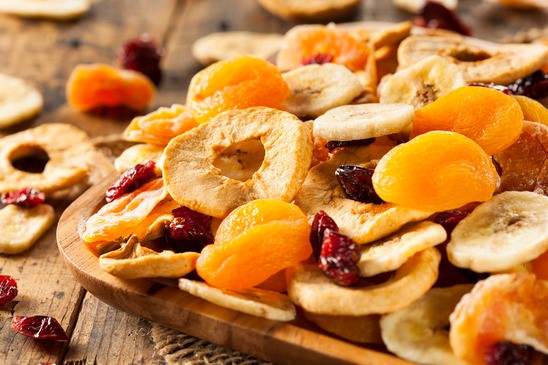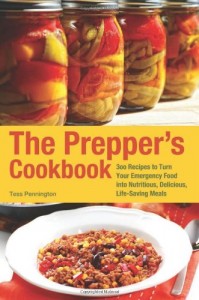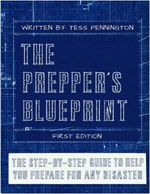This article was originally published by Lisa Egan at Tess Pennington’s ReadyNutrition.com
Tess is the author of The Prepper’s Blueprint: How To Survive ANY Disaster

Natural disasters like hurricanes, Nor’easters, and winter storms can cause you to be stuck in your home for days (or even weeks) on end – and stuck eating whatever you currently have stashed in your pantry and freezer.
Normally, enough notice is provided to allow time to run out to purchase items prior to a storm’s arrival. It is tempting to stock up on convenient comfort foods before a disaster, but this isn’t ideal. For example, many freeze-dried foods are notorious for having excessive amounts of sodium – thus causing you to consume more water to make up for it (oops, there goes your stored water supply!). Staying hydrated in winter is especially important – your body needs more water during winter than it does during the warmer months. And, remember – you will need to store enough water for drinking AND for cooking.
Surviving on your favorite junk foods may leave you feeling dehydrated, drained, and stressed, which will make enduring a sustained emergency situation even more difficult.
Building an adequate emergency pantry takes time and planning to make it fully functional. Ideally, you will store nutritious shelf-stable foods that your family normally consumes (and enjoys), as well as foods that serve many purposes.
Learn how to build a well-stocked pantry using a layering system: The Prepper’s Cookbook: 300 Recipes to Turn Your Emergency Food into Nutritious, Delicious, Life-Saving Meals, or The One-Year Pantry, Layer by Layer.
How to build a pantry stocked with nutritious, energizing foods
When selecting foods to add to your emergency pantry, focus on the most nutrient-dense items you can find that are also shelf-stable, with a focus on macronutrients.
Macronutrients are compounds found in all foods that humans consume in the largest quantities, providing the bulk of our calories (energy) from our diets. The three main categories are protein, carbohydrate, and fat.
You’ll want your pantry to have a diverse assortment of foods from all three macronutrient categories.
Protein is the most satiating macronutrient – in other words, it is the most filling. Carbohydrates come in second to protein, and fat takes third place.
Fiber is also filling, so including it in meals can reduce mindless snacking (which humans are prone to do when boredom sets in – and let’s face it, being stuck indoors for days on end can get boring).
In a previous article, we stressed that the foods you store for emergencies should provide you with the energy you’ll need during challenging times. Finding foods that are high in complex carbs and dietary fiber are more efficient from a dietary standpoint and will keep you feeling fuller longer.
To build balanced meals, including a source of each: protein, carbohydrate (ideally with fiber), and fat. Low carbohydrate vegetables (like broccoli and leafy greens) have no limits – add them to meals generously.
Here are some sample meal ideas that include each of the macronutrients:
- Eggs (protein), spinach and tomatoes, cheese (protein/fat), whole grain toast (carb/fiber), and butter (fat)
- Chicken (protein), vegetables, brown rice (carb/fiber), olive oil (fat)
- Steak (protein), salad with leafy greens, potato – sweet or white (carb/fiber), almonds (fat), salad dressing – olive oil w/balsamic vinegar and herbs (fat)
If you are unable to cook, you’ll need sources of each macronutrient in shelf-stable, ready-to-eat form, so we have included ideas for those in each category.
Protein sources
Protein is made up of amino acids, which are the building blocks for our bodies. If we consume excess protein in our diets, our bodies will usually find a way to use it – we don’t store a lot of extra amino acids like we do carbohydrates and fat. Because we either use or excrete extra protein, we need to replenish it through our diets.
Daily protein needs vary among individuals. Body composition, activity level, and overall health are factors that need to be considered when calculating protein needs. A VERY general guideline is one gram of protein per pound of body weight for healthy adults.
You likely already know that eggs, poultry, and meat are good sources of protein, but what about shelf-stable sources?
Here are some options to consider:
- Protein bars: There are many, many varieties available to choose from, and they are not created equal. Read labels, and be sure to select bars that aren’t loaded with sugar. The RXBAR brand is a good choice – these whole food bars provide 12 grams of protein in 210 calories or less and are available in a wide variety of flavors, including Almond Butter, Peanut Butter, Chocolate Sea Salt, Blueberry, and Mixed Berry. These bars are among my personal favorites and have no added sugar, and are gluten, soy, and dairy free. Oh, and the shelf life is 10 months from the time they are made. Not bad for a whole food bar that contains no preservatives.
- Protein powder: Varieties include whey, casein, egg, soy, vegetable, pea, rice, and hemp. Look for brands that do not contain added sugar or fillers. The fewer ingredients, the better. My personal favorite is Nutiva Organic Hemp Protein but there are many to choose from. Naked Nutrition makes nearly every kind of protein powder possible, and with minimal ingredients. All you need to make a basic protein shake is the powder and water. If you are able to use a blender, you can add more ingredients – like frozen fruits and vegetables – to make protein shakes and smoothies. To make your protein shakes and smoothies extra nutritious, you can add a scoop of a green food powder. Nativas Organics offers delicious superfood powders.
- Jerky and air-dried beef: You can either purchase jerky, or make your own jerky or pemmican. When making your own, you can purchase cheaper cuts of meat, marinate it and dehydrate it. An alternative to traditional jerky is air-dried aged beef, like these, from Kalahair Biltong.
- Dehydrated meat: You can purchase this, or make your own – here’s how: Dehydrating Meat Sources for Your Food Pantry.
- Bone broth: This is very nutritious stuff, and is versatile. It can be heated and eaten like soup or sipped on like a hot beverage. Make your own with leftover chicken carcasses from dinner or purchase beef soup bones. Slow cook your soup and freeze it for later use. In the event of an emergency, you can take out one bag at a time and place in the refrigerator. This will keep the refrigerator temperature down in extended off-grid emergencies. Additionally, you can your bone broth for longer longevity.
- Protein pancakes or waffles: Kodiak Cakes Power Cakes mix is a great pantry addition and will come in handy if you are able to cook.
- Beans and lentils: High in fiber, protein, minerals, and vitamins, beans and lentils are a nutritious pantry stable. In fact, beans and rice are a complete protein source! Smaller beans have shorter cook times and will conserve limited fuel sources in an emergency (keep cook times in mind when stocking food for emergencies).
- Dried milk: A common emergency pantry item, powdered milk is high in protein and can be used for many purposes.
Carbohydrate and fiber sources
Many preppers find solace in growing produce from their gardens and preserving the fresh grown fruits and vegetables. Doing so gives them a constant supply of food to put away and seeds for the next year (provided that the seeds they use are non-GMO).
Fortunately, it is not difficult to find nutritious shelf-stable sources of carbohydrates and fiber.
- Dehydrated fruits and vegetables: Dehydrating vegetables and fruits for long-term storage is a great way to get needed nutrition into diets with minimal investment. The dehydration process removes moisture from the food so that bacteria, yeast, and mold cannot grow. The added benefit is the dehydration process minimally affects the nutritional content of food. Dehydrated foods can last for 12 months or longer, provided they have been stored properly. Choose fruits and vegetables that are the most calorie dense. Look for small boxes of dried fruits for easy meal assembly. For best results, follow these rules when dehydrating.
- Freeze-dried fruits and vegetables: Freeze-dried foods are emergency pantry favorites because their shelf life is much longer compared to dehydrated foods. Due to the freeze-drying process, freeze-dried foods are more expensive, but can last 25 years or longers. So, if you’re looking to ensure your long-term food needs are met, this is a good investment.
- Whole grains: Keeping an assortment of whole grains like wheat and oats in your pantry can provide your family with healthful options in the event of an emergency. Some grains don’t even need to be cooked before eating – you can soak steel-cut oats, bulgur, and whole-grain couscous in water overnight, making perfect ready-to-eat meals – no heating required.
- Granola and dry cereals: These are also good options – just watch the sugar content, because some can be quite high. Rice cakes are another option – spread a little nut butter and/or jam on them, or top them with dried fruit. Dehydrated/dried fruit can be added to granola and cereal and eaten with your choice of milk or made into trail mix that can be eaten as a snack.
- Quinoa: Pronounced “keen-wah”, this unique food is often classified as a grain, but it is technically a seed. Quinoa is gluten-free, high protein, high fiber, and packed with nutrients. Use it to make nutritious snack bars, or try this fritters recipe.
Fat sources
Usually, fat sources that are solid at room temperature last longer on your pantry shelf. Fat sources can go rancid over time, and not only do they taste terrible when that happens, but they also aren’t good for your health. To increase the life of your fat sources, store them in a cool dark place, out of direct sunlight. Don’t let water get into the containers, and use a clean utensil every time you scoop a bit out.
- Ghee: A type of highly clarified butter that’s popular in South Asian and Middle Eastern cooking, ghee is made by removing all the moisture and milk solids from butter. This makes it lactose-free and provides a higher smoke point than regular butter. Ghee has a longer shelf life than regular butter, both refrigerated and at room temperature. It does not need to be refrigerated, even after you open the jar. Most ghee is shelf stable for up to a year, as long as it is stored in a cool, dark place. Ghee is naturally rich in Vitamins A, E, and K, Omega-3, CLA, and butyric acid.
- Coconut oil: Coconut oil is solid at room temperature and melts at a low temperature. It can withstand high heat, unlike many other cooking oils. It can be used for sautéing, baking, roasting, and even frying. You can use it to replace butter in many recipes. There are two main types of coconut oil: refined/expeller-pressed and unrefined/extra-virgin (or virgin). The refined version does not taste or smell like coconut and can be used in recipes where you don’t want to taste any trace of coconut. Check to be sure the brand you buy doesn’t use solvents in the refining process. Oh, and coconut oil can be used for many things – to learn more about that, see 39 Manly Uses for Coconut Oil in Your Bushcraft Kit.
- Olive oil: Long revered for its known health benefits, olive oil is an excellent fat source to keep in your pantry. The shelf life of olive oil varies based on the type of container it is stored in, and freshness when purchased. It generally is best if used within a year of pressing. Olive oil typically lasts for 18 months to 3 years, opened or unopened. Store your olive oil in a cool dark place, away from sunlight – and don’t keep it near the stove (the heat can cause it to go bad faster).
- For more on oils, how to store them, and the average shelf of various oils, check out this handy resource: How Long Does Oil Last?
- Nuts and seeds: This food source is one of the most nutrient dense foods and contains fiber, which can help you stay full longer. Nuts also contain protein. Seeds like chia seeds are especially high in nutrient content. Look for lower-salt varieties. The shelf life of nuts varies a lot, according to the type of nut, when they were bought, and how they are stored. Most nuts (and nut flours) can be stored in the freezer, which makes long-term storage of the kinds your family likes easier. The fresher the nuts are when you buy them, the better. Nuts are usually best kept in your refrigerator, especially when the weather is warm – they can become rancid more quickly in warm environments. Store them in sealed bags or containers. This chart from Eat By Date provides more detailed information on shelf life for specific nuts: How Long Do Nuts Last?
- Nut butters: If your family doesn’t burn through nut butters as fast as mine does, purchase them in smaller packages. Some nut butters do need to be refrigerated. Justin’s Nut Butter brand makes single-serving packets which are perfect for bug out bags or if you are making your own MREs (meals ready to eat) Read labels – some nut butters contain added oils and sugar. Or, make your own – all you need is a blender or food processor, nuts, and jars or storage containers.
Beverages
Of course, water should be your top priority when it comes to building your emergency pantry.
However, there are various reasons you may want to include other things to drink in your emergency pantry. Many of us can’t imagine going a day without coffee, for example. In fact, during a long emergency situation – especially during the colder months – coffee can be a great source of comfort. Thankfully, there are ways to prepare coffee without electricity, should your power go out.
Instant coffee, powdered milk, rice milk, almond milk, and other non-dairy beverages can be stored in the pantry until ready to use (must be kept cold after opening, so buy small containers if you won’t use them up in one day).
Tea can provide comfort and nutrients during emergency situations, so consider keeping a variety of herbal options in your pantry.
And there you have it!
Hopefully, you’ll find the ideas presented here helpful when you are building your emergency pantry. Are there any items you’d add that we left out? Please feel free to share in the comments.
Be well!
Additional Reading:
8 Nutritious Foods You Can Afford When You’re Practically Broke
Prepping for a Full On Breakdown? Stockpile These Foods
5 (More) Foods That Last Forever
Tess Pennington is the author of The Prepper’s Blueprint, a comprehensive guide that uses real-life scenarios to help you prepare for any disaster. Because a crisis rarely stops with a triggering event the aftermath can spiral, having the capacity to cripple our normal ways of life. The well-rounded, multi-layered approach outlined in the Blueprint helps you make sense of a wide array of preparedness concepts through easily digestible action items and supply lists.
Tess is also the author of the highly rated Prepper’s Cookbook, which helps you to create a plan for stocking, organizing and maintaining a proper emergency food supply and includes over 300 recipes for nutritious, delicious, life-saving meals.
Visit her website at ReadyNutrition.com for an extensive compilation of free information on preparedness, homesteading, and healthy living.











0 Comments